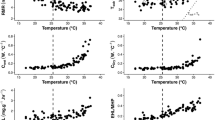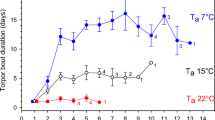Summary
-
1.
Body temperatures (T b), rates of oxygen consumption (\(\dot V_{O_2 }\)) and the loss in body mass of the small insectivorous dasyurid marsupialAntechinomys laniger were determined at different ambient temperatures (T a).
-
2.
Most animals entered torpor belowT a 27°C when food was witheld. Spontaneous torpor was observed frequently atT a 19 and 12.5°C.
-
3.
An increase in\(\dot V_{O_2 }\) and ΔT (T b-T a) was observed during torpor below aT a of about 11°C. The lowest individualT b measured was 11.0°C.
-
4.
The linear increase in\(\dot V_{O_2 }\) during torpor belowT a 11°C was parallel to theT a related increased in metabolism of normothermic resting, active, and arousing animals.
-
5.
Torpor lasted between 2 and 16 h and the longest durations were observed atT a 13–20°C; below and above this temperature range torpor bouts were shorter.
-
6.
The lowest relative weight loss was observed at theT a of the longest torpor bouts and lowest metabolism during torpor.
-
7.
Both the time of the activity peaks and onset of torpor were dependent onT a and were observed later in the night at higherT a. Torpor commenced before the onset of light.
-
8.
Arousal rates were rapid and the arousal times increased exponentially with decreasing Ta.
Similar content being viewed by others
Referneces
Aslin HJ (1982) Small dasyurid marsupials: their maintenance and breeding in captivity. In: Evans DD (ed) The mangagement of Australian mammals in captivity. The Zoological Board of Victoria, Melbourne, pp 22–27
Dawson TJ, Wolfers JM (1978) Metabolism, thermoregulation and torpor in shrew sized marsupials of the genusPlanigale. Comp Biochem Physiol 59A:305–309
Dawson TJ, Dawson WR (1982) Metabolic scope in response to cold in some dasyurid marsupials and Australian rodents. In: Archer M (ed) Carnivorous marsupials. R Zool Soc New South Wales, Sydney, pp 255–260
Eisentraut M (1956) Der Winterschlaf mit seinen ökologischen und physiologischen Begleiterscheinungen. Gustav Fischer, Jena, pp 25–27
Folk GE (1957) Twenty-four hour rhythms of mammals in a cold environment. Am Nat 91:153–166
French AR (1982) Effects of temperature on the duration of arousal episodes during hibernation. J Appl Physiol 52:216–220
Geiser F, Augee ML, McCarron HCK, Raison JK (1984) Correlates of torpor in the insectivorous dasyurid marsupialSminthopsis murina. Aust Mammal 7:185–191
Geiser F (1985a) Tagesschlaflethargie bei der gelbfüßigen BreitfußbeutelspitzmausAntechinus flavipes (Marsupialia: Dasyuridae). Z Säugetierkd 50:125–127
Geiser F (1985b) Hibernation in pygmy possums (Marsupialia: Burramyidae). Comp Biochem Physiol 81A:459–463
Gieser F, Baudinette RV (1985) The influence of temperature and photophase on daily torpor inSminthopsis macroura (Dasyuridae: Marsupialia). J Comp Physiol B 156:129–134
Geiser F, Matwieczyk L, Baudinette RV (1986) From ectothermy to heterothermy: the energetics of the KowariDasyuroides byrnei (Marsupialia: Dasyuridae). Physiol Zool 59 (in press)
Hayden P, Lindberg RG (1976) Survival of laboratory-reared pocket mice,Perognathus longinembris. J Mammal 57:266–272
Heinrich B, Bartholomew GA (1971) An analysis of pre-flight warm-up in the sphinx moth,Manduca sexta. J Exp Biol 55:223–239
Hinds DS, MacMillen RE (1984) Energy scaling in marsupials and eutherians. Science 225:335–337
Hudson JW (1965) Temperature regulation in the pigmy mouse,Baiomys taylori. Physiol Zool 38:243–254
Hudson JW, Scott JM (1979) Daily torpor in the laboratory mouseMus musculus var albino. Physiol Zool 52:205–218
Johansen K, Krog J (1959) Diurnal body temperature variations and hibernation in the birchmouse,Sicista betulina. Am J Physiol 196:1200–1204
Kayser C (1961) The physiology of natural hibernation. Pergamon Press, Oxford, pp 30–33
Lasiewski RC, Acosta AL, Bernstein MH (1966) Evaporative water loss in birds — 1. Characteristics of the open flow method of determination, and their relation to estimates of thermoregulatory ability. Comp Biochem Physiol 19:445–457
Lyman CP, O'Brien RC, Greene GC, Papafraugos ED (1981) Hibernation and longevity in the Turkish hamster,Mesocricetus brandti. Science 212:668–670
MacMillen RE, Nelson JE (1969) Bioenergetics and body size in dasyurid marsupials. Am J Physiol 217:1246–1251
Morton SR, Lee AK (1978) Thermoregulation and metabolism inPlanigale maculata (Marsupialia: Dasyuridae). J Therm Biol 3:117–120
Nagel A (1977) Torpor in the European white-toothed shrews. Experientia 33:1455–1456
Pajunen I (1983) Ambient temperature dependence of the body temperature and of the duration of the hibernation periods in the garden dormouse,Eliomys quercinus L. Cryobiology 20:690–697
Tucker VA (1962) Diurnal torpidity in the California pocket mouse. Science 136:380–381
Twente JW, Twente JA (1965) Regulation of hibernating periods by temperature. Proc Natl Acad Sci USA 54:1058–1061
Valente A (1983) Kultarr,Antechinomys laniger. In: Strahan R (ed) Complete book of Australian mammals. Angus and Roberston, Sydney, p 73
Vogt FD, Lynch GR (1982) Influence of ambient temperature, nest availability, huddling, and daily torpor on energy expenditure in the white-footed mousePeromyscus leucopus. Physiol Zool 55:56–63
Wallis RL (1976) Torpor in the dasyurid marsupialAntechinus stuartii. Comp Biochem Physiol 53A:319–322
Wallis RL (1979) Responses to low temperature in small marsupial mammals. J Therm Biol 4:105–111
Wallis RL (1982) Adaptation to low environmental temperatures in the carnivorous marsupials. In: Archer M (ed) Carnivorous marsupials. R Zool Soc New South Wales, Sydney, pp 285–290
Wang LCH, Hudson JW (1971) Temperature regulation in normothermic and hibernating chipmunk,Tamias striatus. Comp Biochem Physiol 38A:59–90
Withers PC (1977) Measurement of 757-1, 757-2 and evaporate water loss with a flow-through mask. J Appl Physiol 42:120–123
Author information
Authors and Affiliations
Rights and permissions
About this article
Cite this article
Geiser, F. Thermoregulation and torpor in the Kultarr,Antechinomys laniger (Marsupialia: Dasyuridae). J Comp Physiol B 156, 751–757 (1986). https://doi.org/10.1007/BF00692755
Accepted:
Issue Date:
DOI: https://doi.org/10.1007/BF00692755




